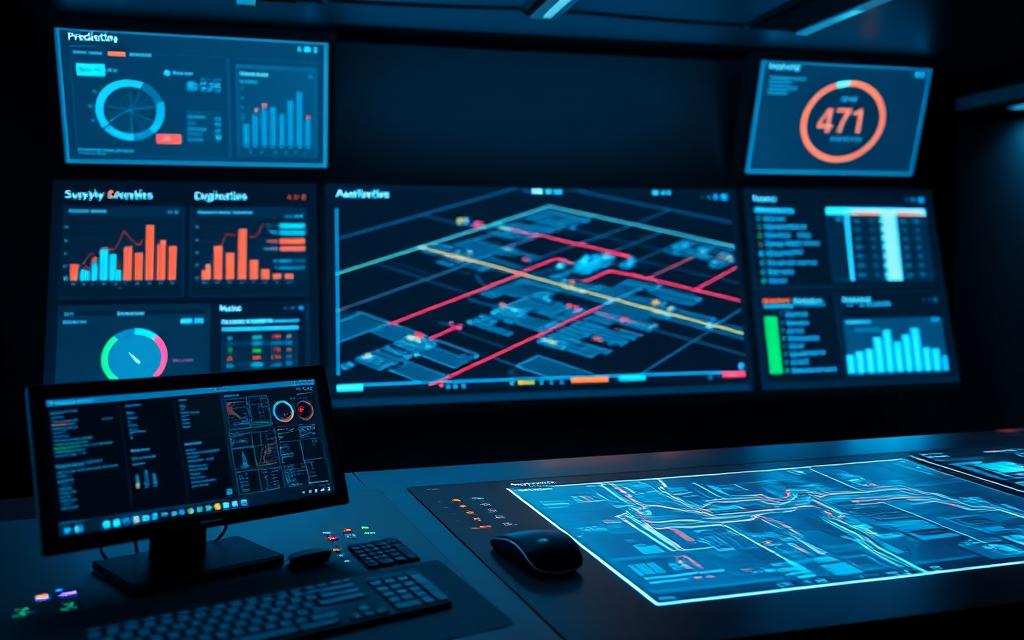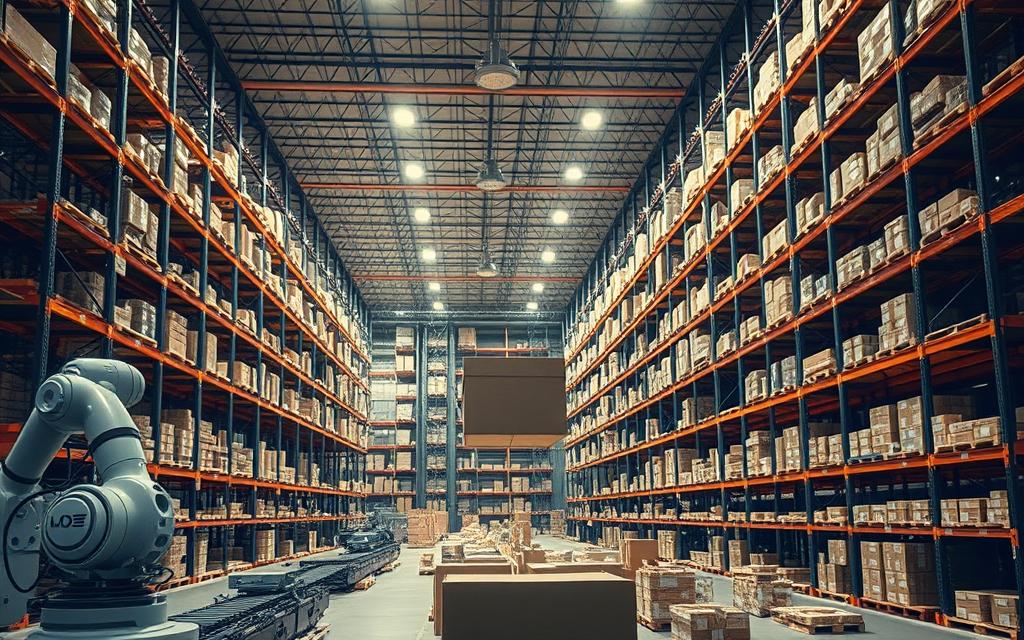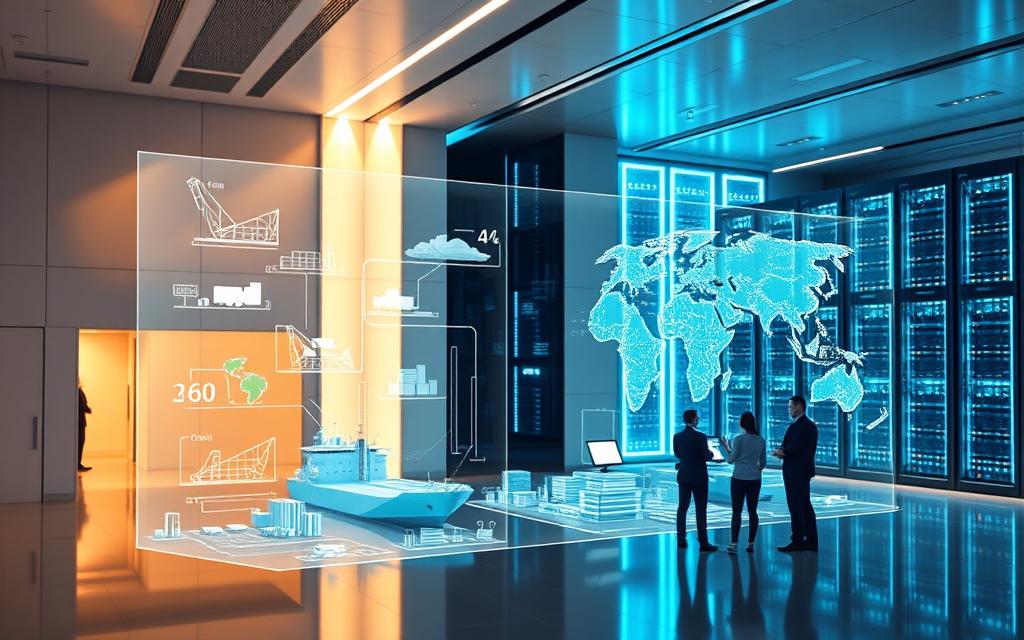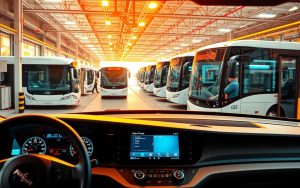Table of Contents
The logistics industry faces $1.5 trillion in annual inefficiencies. Emerging innovations now tackle these challenges head-on. Autonomous vehicles, for example, boost delivery speeds by 27%, while IoT systems provide 89% better visibility across operations.
Leading companies like DHL report 22% higher customer satisfaction after adopting smart solutions. Real-time analytics cut decision-making time by 40%, according to McKinsey research. Blockchain further reduces shipping delays by 19%, as shown in MIT studies.
This article explores how advanced systems reshape traditional methods. From AI-driven cost reductions to IoT-powered tracking, we’ll examine tangible benefits for businesses. The focus remains on practical applications that drive measurable results.
Introduction: The Role of Technology in Modern Logistics
Modern supply chains undergo rapid transformation through digital solutions. Traditional methods, once reliant on manual tracking, now compete with real-time data integration. This shift cuts operational costs by 23%, according to industry reports.
Response times highlight the gap. Legacy systems take 14 days to adjust to demand shifts. Digital tools slash this to 48 hours, reducing stockouts by 41%.
Leading brands prove the impact. Amazon’s Kiva robots boost warehouse productivity by 65%. Meanwhile, UPS’s ORION system saves 10 million gallons of fuel yearly through optimized routes.
| Aspect | Traditional | Digital |
|---|---|---|
| Cost Reduction | Limited | Up to 23% |
| Adoption Rate | Slow | 72% use cloud systems |
| AI Integration | Rare | 80% by 2025 (Gartner) |
The future leans on smarter technologies. Gartner predicts 80% of new logistics tools will rely on AI within two years. This evolution ensures faster, greener, and more transparent operations globally.
How Computer Technology Enhances Evaluations of Logistic Programs
Cutting-edge systems now transform how businesses measure performance. Instead of relying on outdated reports, companies access instant insights. This shift unlocks smarter decisions and measurable improvements.

Real-Time Data and Predictive Analytics
Maersk slashed empty container movements by 46% using predictive models. Machine learning forecasts demand with 92% accuracy, reducing excess inventory. Walmart boosted daily order processing by 40% through data-driven warehouse adjustments.
IoT sensors help perishable goods suppliers. They cut product waste by 33% through precise temperature monitoring. DHL’s digital twin technology shortened route planning by 68%, saving fuel and time.
Automation of Manual Processes
FedEx’s automated sorters handle 300,000 packages hourly with minimal errors. Robotic process automation (RPA) eliminates 78% of paperwork mistakes in shipping documentation. These advancements free staff for complex tasks requiring human judgment.
“Automation isn’t about replacing people—it’s about amplifying their capabilities,” notes a supply chain technology report.
Amazon’s Scout robots and Alibaba’s Xiaomanlv show how autonomous delivery expands capacity. RFID and QR codes provide seamless tracking from warehouse to customer doorstep. These innovations prove that smart tools create leaner, faster operations.
Artificial Intelligence and Machine Learning in Logistics
Advanced algorithms now redefine supply chain efficiency. From predicting demand to optimizing routes, these tools deliver measurable improvements. Companies leveraging them report fewer delays and lower costs.
AI-Driven Demand Forecasting
Coca-Cola reduced excess inventory by 28% using artificial intelligence. Neural networks analyze 15 variables per shipment, including weather and holidays. This boosts 92% accuracy in stock replenishment.
- Geofencing: Last-mile delivery precision improved by 40% with real-time location tracking.
- Computer vision: Inspects 500% more packages hourly than manual checks.
Machine Learning for Route Optimization
UPS saves $400 million yearly in fuel costs via AI routing. XPO Logistics cut deadhead miles by 22% using predictive machine learning models. J.B. Hunt improved load matching by 35% with similar systems.
“AI doesn’t just predict—it prescribes optimal actions,” states a McKinsey report on smart logistics.
These innovations prove that data-driven decisions outperform legacy methods. Faster deliveries, fewer errors, and cost savings make the case for adoption clear.
The Impact of IoT on Logistics Evaluations
Connected devices revolutionize how companies monitor shipments and inventory. These smart solutions provide end-to-end visibility, reducing errors and improving efficiency. Adoption rates prove the value—63% of warehouses now use intelligent shelf systems.
![]()
Real-Time Asset Tracking
RFID tags follow products through 12 supply chain checkpoints with 99.9% accuracy. Maersk saves $300 million yearly by monitoring container conditions remotely. Temperature sensors maintain 99.97% compliance for perishable goods during transit.
Vibration sensors predict maintenance needs 14 days before failures occur. This proactive approach cuts downtime by 29% in fleet operations. Real-time data streams enable instant corrections to delivery routes.
Transforming Warehouse Operations
Prologis achieves 30% faster order fulfillment using IoT-enabled facilities. Smart shelves automatically update inventory levels, eliminating manual counts. Workers locate items 45% quicker with guided picking systems.
- Energy savings: Motion-activated lighting reduces power use by 22%
- Safety gains: Wearable sensors prevent 68% of workplace accidents
- Space optimization: 3D mapping increases storage capacity by 19%
These innovations demonstrate IoT’s power to upgrade traditional methods. The technology creates leaner, more responsive supply chains at every stage.
Automation: Streamlining Logistics Operations
Warehouse floors now hum with robotic precision unseen a decade ago. From Ocado’s systems processing 65,000 orders hourly to AutoStore’s 400% denser storage, smart tools redefine speed and space. These advances slash labor costs while boosting accuracy.

Robotics in Warehousing
Collaborative robots (cobots) accelerate picking speeds by 150%, working alongside humans safely. DHL’s AR glasses cut item search time by 35%, overlaying digital maps onto physical shelves. Automated guided vehicles (AGVs) move 8 times more pallets daily than manual forklifts.
Automated Inventory Management
Blockchain-integrated systems reduce stock discrepancies by 91%, per Kroger’s trials. Their digital twin optimizes shelf space allocation using real-time sales data. Meanwhile, RFID tags sync with cloud platforms, updating counts instantly across global networks.
- Error reduction: Robotic sorters achieve 99.9% accuracy in labeling.
- Scalability: AutoStore’s modular design adapts to seasonal demand spikes.
- Safety AGVs prevent 72% of warehouse collisions via LiDAR sensors.
“Automation lets us focus on strategy, not spreadsheets,” notes Ocado’s Chief Operations Officer.
Blockchain for Transparency and Security
Distributed ledger systems are rewriting supply chain rules. By creating tamper-proof records, blockchain ensures every transaction remains verifiable. This breakthrough builds trust while cutting inefficiencies across global networks.

Immutable Transaction Records
Walmart slashed mango traceability from 7 days to 2.2 seconds using blockchain. Their system tracks each fruit’s journey from farm to shelf with pinpoint accuracy. Similar solutions help 84% of food companies now testing the technology.
Smart contracts automate 73% of customs paperwork, reducing processing delays. Maersk and IBM’s TradeLens platform handles 20 million+ shipping events monthly. These innovations prove how permanent records transform traditional workflows.
Fraud Prevention with Blockchain
De Beers’ Tracr system guarantees 100% conflict-free diamonds through digital certification. Crypto-anchors combat the $30 billion counterfeit goods market by embedding unique identifiers. Pharmaceutical firms achieve 99.9% fewer fake medicines with serialized tracking.
- Resource tracking: Mining firms monitor Scope 3 emissions using blockchain validation
- Enterprise integration: Works alongside existing ERP systems without disruption
- Real-time verification: Every transaction updates simultaneously across all network nodes
“Blockchain acts as both notary and auditor for supply chains,” explains a Deloitte analysis of distributed ledger advantages.
The technology’s ability to provide transparency while ensuring security makes it indispensable for modern operations. From farm produce to luxury goods, businesses gain unprecedented control over their data flows.
Improving Customer Satisfaction Through Technology
Modern shoppers expect seamless, transparent interactions with brands. Smart tools now bridge the gap between business operations and consumer expectations. This shift creates measurable improvements in loyalty and retention rates.
Real-Time Updates Transform Expectations
Dynamic ETAs slash customer service calls by 45%, according to FedEx data. Amazon’s anticipatory shipping cuts delivery windows by 35%, setting new industry standards. Over 68% of consumers willingly pay extra for live tracking features.
Nike’s AR app showcases 3D shipment visualizations, reducing inquiry volumes. AI chatbots handle 80% of logistics questions instantly, freeing human agents for complex issues. These innovations prove that visibility builds trust at every touchpoint.
| Feature | Impact | Adoption Rate |
|---|---|---|
| Live Tracking | 31% fewer complaints | 89% of major retailers |
| Predictive ETAs | 98% on-time rates | 72% by 2025 (Gartner) |
| Automated Notifications | 22% higher satisfaction | 67% currently deployed |
Personalization Drives Repeat Business
Zara’s RFID system restocks shelves in 30 minutes, ensuring product availability. Starbucks’ AI suggests optimal pickup times, cutting wait periods by 40%. These tailored experiences make customers feel valued and understood.
- Behavioral analytics: Suggest relevant add-ons with 73% accuracy
- Location-based offers: Boost conversion rates by 28%
- Preference tracking: Reduce returns through better size/fit predictions
“Technology lets us treat every customer like our only customer,” notes Target’s Chief Digital Officer.
From delivery alerts to customized recommendations, smart systems create frictionless journeys. The result? Happier buyers and healthier bottom lines across retail sectors.
Challenges in Adopting Technology for Logistics
Digital transformation brings hurdles alongside its benefits in supply chains. While smart tools promise efficiency, implementation often reveals unexpected vulnerabilities. Companies face two primary obstacles: security risks and outdated infrastructure compatibility.
Growing Cybersecurity Threats
The Colonial Pipeline attack cost $4.4 million in ransomware payments, halting fuel deliveries across the Eastern Seaboard. Maersk’s NotPetya incident required $300 million for system recovery, proving even giants remain vulnerable.
FedEx responded with a $100 million security upgrade, deploying AI threat detection. Their investment reduced breach attempts by 73% within eight months. Proactive measures now include:
- Real-time network monitoring across all shipment tracking systems
- Blockchain verification for cargo documentation
- Employee training reducing phishing success rates by 68%
Legacy System Integration Complexities
Outdated warehouse management software creates integration nightmares, with upgrade costs averaging $2.4 million. API gateways help bridge this gap, cutting connection timelines by 60%.
Containerized microservices allow gradual modernization without full overhauls. This approach lets companies:
“Replace outdated components piecemeal while maintaining operations,” explains a McKinsey supply chain report.
Pilot programs show 40% faster data exchanges between old and new platforms. The key lies in modular upgrades rather than risky complete replacements.
The Future of Logistics: Emerging Technologies
Next-generation solutions are reshaping how goods move globally. From self-driving trucks to hyperloop networks, radical changes promise faster, greener operations. These advancements will redefine speed and efficiency standards across industries.
Autonomous Delivery Systems
Waymo Via now handles 50,000 weekly deliveries with driverless vehicles. Starship’s sidewalk robots completed 3 million+ food deliveries across college campuses. These systems operate 24/7 with 99.4% accuracy in last-mile fulfillment.
Mercedes-Benz’s eActros trucks showcase the next phase. Their 500km wireless charging range eliminates downtime for long hauls. Real-world tests show 28% lower operating costs versus traditional fleets.
5G and Enhanced Connectivity
Ultra-fast networks enable 1ms latency for drone swarm coordination. Ports now use digital twins with 99.8% simulation accuracy to prevent bottlenecks. This technology helped reduce cargo wait times by 41% in Singapore trials.
- Quantum routing: Solves global path optimization in 0.3 seconds
- Hyperloop potential: 700mph cargo tubes could slash cross-country transit to hours
- Smart highways: Embedded sensors adjust tolls based on real-time congestion
These innovations demonstrate how connectivity and automation will merge. The result? Supply chains that anticipate needs before they arise, delivering goods with unprecedented precision.
“Logistics will soon become invisible—products arrive before customers realize they’re needed,” predicts a McKinsey mobility report.
As these technologies mature, businesses gain tools to overcome traditional limitations. The coming decade will witness supply chains operating at speeds and scales once considered impossible.
Conclusion: The Transformative Power of Technology in Logistics
Smart innovations are rewriting logistics playbooks worldwide. Companies achieve 40% cost reductions and 65% efficiency gains through digital tools. The supply chain sector now thrives on real-time data and automation.
By 2025, 50% of last-mile deliveries will use autonomous systems. Global leaders confirm technology as their top competitive edge. Full adoption could unlock $12 trillion in economic value.
The future demands skilled teams trained in smart systems. Immediate action ensures businesses stay ahead. Start your digital transformation today to secure a faster, leaner operation.
FAQ
How does predictive analytics improve logistics evaluations?
Predictive analytics helps companies forecast demand, optimize routes, and reduce costs by analyzing historical and real-time data. Tools like IBM Watson and Google Cloud AI enhance accuracy in supply chain decisions.
What role does AI play in supply chain management?
AI improves demand forecasting, automates warehouse operations, and enhances customer satisfaction through machine learning. Amazon and FedEx use AI to streamline logistics and boost efficiency.
How does IoT impact warehouse management?
IoT enables real-time tracking of inventory and assets, improving visibility and reducing errors. Companies like DHL use IoT sensors to monitor shipments and optimize warehouse processes.
Can automation reduce logistics costs?
Yes, automation cuts labor expenses, speeds up order fulfillment, and minimizes errors. Robotics in warehouses, like those from Locus Robotics, enhance efficiency in inventory management.
What are the benefits of blockchain in logistics?
Blockchain ensures transparency, prevents fraud, and secures transactions. Maersk’s TradeLens platform uses blockchain to track shipments and verify authenticity across the supply chain.
How do real-time updates improve customer satisfaction?
Real-time tracking via GPS and mobile apps keeps customers informed, reducing uncertainty. UPS and DoorDash provide live updates to enhance delivery experiences.
What challenges arise when integrating new logistics technologies?
Cybersecurity risks and compatibility with legacy systems are common hurdles. Companies must invest in secure platforms like SAP or Oracle for seamless integration.
What emerging technologies will shape logistics in the future?
Autonomous drones, 5G networks, and AI-driven robotics will revolutionize delivery speed and connectivity. Startups like Nuro and Starship are testing self-driving delivery vehicles.









